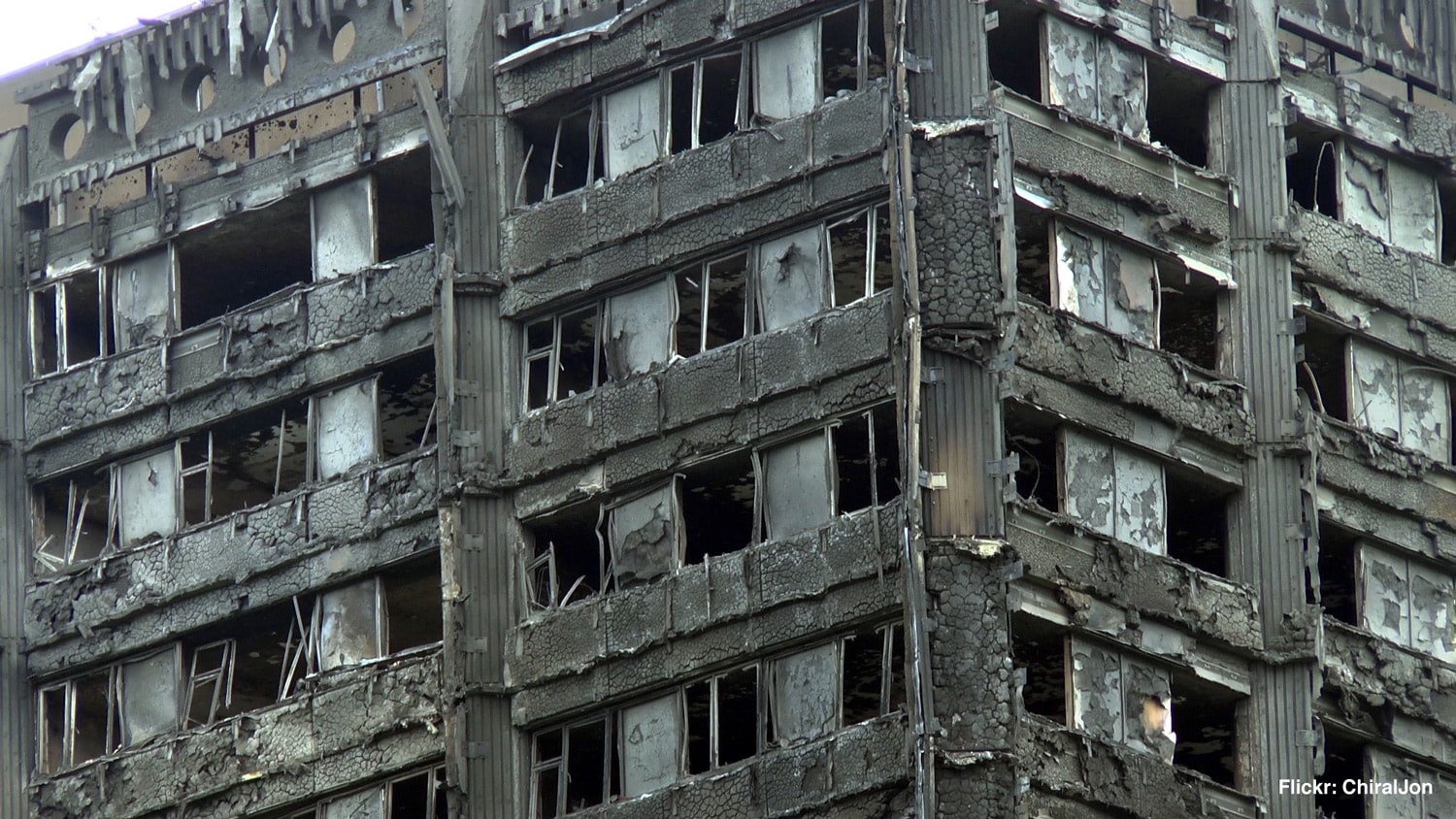
Briefing: Building Safety Manager - developing a competence programme
Last year, the British Standards Institution (BSI) started work on the 'Built Environment Competence Programme', an industry-led programme that aims to raise the standards of workforce competence across the built environment. In July, the Building Safety Bill was published, outlining the new role of Building Safety Manager (BSM). As part of the competence programme, BSI has drafted a competence framework for the BSM role. The framework specifies building safety competence for the BSM's role, functions, activities and tasks. BSI is now seeking the views of people who work in the housing, construction, fire, and safety industries.
Download and comment on the draft framework
Following the Grenfell tragedy, there is an identified need to improve building safety performance by focusing upon improving the competence and the behaviour (in particular, the integrity to see the ‘job’ through properly) of the workforce at all levels.
The focus is on the improvement in the competence of individuals, rather than relying, as we have in the past, on their employing organisation attesting to the individual’s competence. The capability and resources of organisations will also need to be more thoroughly established and monitored on a regular basis to ensure the organisation and its workforce remain competent to deliver safety and manage risks effectively. This will be particularly important in HRBs (High Risk Buildings).
Earlier this year, International Workplace’s Kelly Mansfield spoke to Anthony Taylor, Chairman of Working Group 8 (WG8), which was set up as one of the working groups within the CIC’s Competence Steering Group (CSG). The CSG was part of industry’s response to Dame Judith’s challenge to ‘step-up’ and comprised 12 Working Groups representing industry stakeholder disciplines. All were charged with developing competence frameworks, appropriate for the post-Grenfell era, for the workforce within their respective disciplines.
In this briefing, they discuss the importance of competence, specifically in relation to the Building Safety Manager, and why it plays such an important role in making the improvements Dame Judith Hackitt sought.
KM: What was the plan for WG8?
AT: Each of the working groups were charged with delivering a ‘competence framework’ for their specific group. WG8’s Building Safety Manager was a brand-new role, envisioned by Dame Judith, and we therefore had to start by ‘imagineering’ what the role was, and the environment/relationships that would impact on the role.
KM: Do we have to wait for legislation (Building Safety Bill) to be finalised before we can create the role of BSM? What can we do in the meantime?
AW: The BSM can be either an individual person, or an organisation. If an organisation takes the role they must appoint at least one ‘Nominated Individual’ (NI).
The answer to your question is no, and Dame Judith exhorts industry to get on with it. The Building Safety Bill has now had its second reading in Parliament (July), so it is definitely on the way, and depending on the journey through the Parliamentary processes it is anticipated to become law in May 2023. However, the individual BSM/NI role is to be subject to a competence framework. The work done by WG8 has been taken to BSI to deliver a PAS (8673). This is out for public consultation (July 2021), and final publication in December 2021. It is, however, anticipated that the function of the BSM may be taken on by organisations; these too will need to be assessed in regard to their appropriate resources, including the competence of their Nominated Individual(s). Work to establish how this is best done is already underway. There are roles advertised, but many that I have read do not equate to Dame Judith’s vision, and none can, yet, be certificated against the forthcoming PAS.
Whilst the Building Safety Manager might be responsible for carrying out certain duties, accountability will always lie with the Accountable Person (AP). The draft Building Safety Bill makes it clear that the actual role of the BSM will be determined by their contract arrangements with the AP.
It is anticipated that the BSM will be required to support the AP to:
- Deliver the Tenants Engagement Strategy.
- Maintain Golden Thread.
- Assist in the AP’s Building Risk Assessment.
- Manage the building in line with the Safety Case Report that the AP is responsible to deliver to the Regulator in order to persuade the Regulator the building is safe to occupy and has all the appropriate management systems to manage the risks in the building and assure the residents of a safe home.
- Advise AP when/if the BSM considers the Building Risk Assessment or Safety Case Report requires review.
- Report information related to the safety of an occupied building to the Building Safety Regulator.
There remains debate as to whether Accountable Persons will require their BSM to respond only to the requirements of the Bill (i.e. ‘spread of fire and structures’) or they will take the view that they want their BSM to take a wider, more holistic, view and require them to also manage public health and other H&S matters that are necessary to maintain a safe building for the residents to live in. My preference is for the latter, a much closer ‘fit’ with the vision of Dame Judith Hackitt, and the work WG8 delivered.
KM: Why has competence been such a key issue in this process?
AT: Dame Judith recognised the lack of competence across the whole industry. Competence is redefined as SKEB – skills, knowledge, experience and behaviour – the last being the truly new issue. After all, you can have all the technical knowledge in the world, but if applied in a slapdash manner, it accounts for nothing. This attitude is being recognised as how we got here – refer to the Grenfell Inquiry!
Dame Judith Hackitt said:
“If you move to a future world where the regulator is going to say, ‘prove to me that this is going to be a safe building’ - the question they will ask is ‘how will you ensure that this is the case?’ The Duty Holder, whether that’s the client, the major contractor, whoever it is, will need be in a position to say ‘because I am employing competent people to do this job, and here is the evidence that I am employing competent people to do this job'. There is no doubt at all that competence and accreditation is going to be a major feature of the future.”
KM: How much of a role is WG8 and its report playing in developing competence requirements?
AT: I, together with others from WG8 and a much wider stakeholder group, are working with BSI to deliver the PAS 8673, a standard for the competence of individual Building Safety Managers and Nominated Individual Building Safety Managers.
WG8 has also gone on to form the ‘Building Safety Alliance’ – some 40+ ‘Council’ members from across this sector, including insurers, social and private housing, and some commercial organisations working in fire risk management. We also have Government, the Regulator, UKAS and the Welsh Government in an observer role, guiding us and listening to the observations of the Building Safety Alliance. It's a not-for-profit, industry-owned and operated company limited by guarantee that we have formed. It will sit within the Construction Industry Council (CIC) ‘umbrella’ of similar organisations, with the initial intent of undertaking independent assessments and certification of prospective BSMs and nominated individuals. It is envisioned that those who are successfully certificated ‘against’ PAS 8673 will then be placed on a national Register operated and governed by the Building Safety Alliance. This is intended to be the pre-eminent source of assurance to Residents, APs, BSM organisations, the Regulator and others that those on the Register are competent to operate as BSM/NIs (depending on the complexity of the buildings for which they are responsible). Once we have the processes in place for assessing individuals, we will be looking to assess BSM organisations, and hopefully placing these too on the Register.
KM: What does competence mean in this scenario?
AT: Competence requirements of individuals in these roles are necessarily wide and they will be defined by the forthcoming PAS 8763. It is the PAS 8673 that the Building Safety Alliance will assess people against. The standard has been available for public consultation from late July, and will be published in final form, for use, in December this year.
While the Building Safety Bill is focused only on spread of fire and structural safety in residential buildings of 18m or seven storeys, the wider challenges related to life and health and safety must not be underestimated as it requires the hearts and minds of all parties to recognise and identify with the changes required not only in technical competences but also equally in attitudes and behaviours.
Dame Hackitt in her Independent Review outlined the need for culture change across the built environment. The key to unlocking this culture change is through encouraging the right behaviours in people and by making behaviours an integral part of competence requirements.
Behaviours are defined as the way in which someone acts or conducts themselves, especially towards others.
Positive behaviour strands were determined and recommended by the work undertaken in WG8 – and this has been passed over to the BSI for further development:
B1 – Honesty: Reliable and trustworthy, treats others with equality and fairness, considers behaviours of others, is open, transparent and honest. Communication is clear and unambiguous.
B2 – Accuracy: Acts with care, performs services competently, keeps knowledge and skills up to date, assists in the development of others, identifies, mitigates and manages risks. Communication is clear and accurate.
B3 – Respect: Safety of others is paramount, ensures work is lawful and justified, recognises the importance of alternative views, respects personal information and intellectual property including confidentiality, protects and embeds a sustainable approach to improve the built and natural environments.
B4 – Integrity: Declares and manages conflicts of interest, avoids deception and takes steps to prevent/reports corrupt practice, professional misconduct, bribery and improper influence.
B5 – Responsibility: Takes ownership of actions, delivers an effective service to ensure safety is delivered. Provides direction to others and challenges others where safety is impacted, or professional concerns are identified.
B6 – Capability: Understands the limits of competence, knowledge and capacity. Recognises that ongoing learning is required to maintain competence.
KM: What makes someone competent? How will it be recognised?
AT: The appropriate SKEB – skills, knowledge, experience and behaviour. The new bit there is behaviour. Because, quite frankly, if you've got all the skills in the world and you don't have the integrity to do the job properly, that's not worth a lot. The whole cultural change that's being pushed through the built environment is centred on improving people's behaviour and integrity, albeit we also need to drive up the general skill-sets too.
The behaviour element of SKEB will be an integral part of the overall assessment against the PAS, undertaken by the Building Safety Alliance
KM: What are the skills that make a BSM competent?
AT: Basically, the Building Safety Bill requires that you need knowledge about spread of fire, and knowledge about structures of the building. The PAS will extend this narrow legal focus to include knowledge about all existing health and safety law, public health, knowledge of how to understand ppm (planned preventative maintenance schedule) and generally operate a building safely. The BSM/NI will need excellent communication skills, not least to bring the residents ‘along with you’ to improve overall risk management.
Because BSMs can't be full-blown experts in everything set out in the PAS, they will need to have adequate overall competence, The intent is BSMs/NIs will need to be ‘competent enough to be confident to challenge experts and the Accountable Person and have the wherewithal to be able to communicate matters of importance to and from residents’.
KM: How will an individual prove their competence?
AT: It is envisaged that Building Safety Alliance will take PAS 8673, and set a process in place that will, initially, encourage potential BSM/NIs to self-assess their competences against the PAS, go away to fill any gaps, perhaps with existing training providers, return to the Alliance to be formally assessed, and, if certificated, placed on the National Register (held by the Alliance).
Part of the assessment is likely to be a portfolio of evidence/logbook to evidence their experience and behavioural traits, followed by a peer interview.
KM: Can an NI (BSM) learn on the job?
AT: Part of the SKEB will include experience – but they will need more. We are working on a ‘driving licence’ style graduation of competence to provide a starting point and career path, with the graduations relating to the complexity of the buildings for which the individuals will be competent to manage.
KM: Does the competence level required change according to the type of building?
AT: Yes, it depends on the complexity of the building. The differences are, for example, a standard block, let's say ten flats of a non-complex building, compared to the Shard. That's got to be different. And it depends on the demography of the residents – are they students, or more elderly, or perhaps infirm people? Is English not their first language? How you manage communication is a key competence skill.
KM: Where do existing roles such as a health and safety manager or facilities manager fit in with these developments?
AT: They could upskill to become a BSM/NI – much may relate to the contract arrangements in place between the Accountable Person (owner), any management company, organisation BSM and the individual BSM/NI. We are anticipating people putting themselves forward from many existing disciplines, engineers for example, as you said from FM and property management or perhaps from a ‘fire safety’ background or from construction.
KM: Are there academic routes to competence?
AT: Technical knowledge will provide part of the route, but there will be no magical ‘course’ as such, as we will still have to judge on experience and behaviour.
KM: Is assessment of competence ongoing?
AT: Yes. How and when is currently undecided but it will potentially be re-evaluated every three years and those on the Register will be required to undertake (and evidence) appropriate CPD.
KM: Can an NI (BSM) delegate responsibilities?
AT: You cannot delegate legal responsibilities – however, the NI will be deployed to manage many others. They will have the personal responsibility to ensure, for and on behalf of the AP, the requirements of the Building Safety Act, as it will become, are met in full. They may also have to meet additional duties if their contract decrees so.
KM: How do competencies of the NI (BSM) differ from those of the organisation BSM?
AT: Very different – one is looking at an individual’s SKEB, the latter looking at how an organisation has the resources, management systems and access to sufficient competent individuals to undertake the role.
KM: Can an organisation BSM be assessed for competence?
AT: Not so much competence in itself, as it is an organisation, rather the appropriate resources (which will include access to necessary competence). They will be assessed by the Regulator as suitable for the specific buildings they are put forward to manage, and the Alliance, with others, is looking at how this is best achieved including appropriate registration.
More information
Read more about the work of WG8 and Dame Judith Hackitt in the final reports below:
Safer people, safer homes: Building Safety Management, WG8 final report




